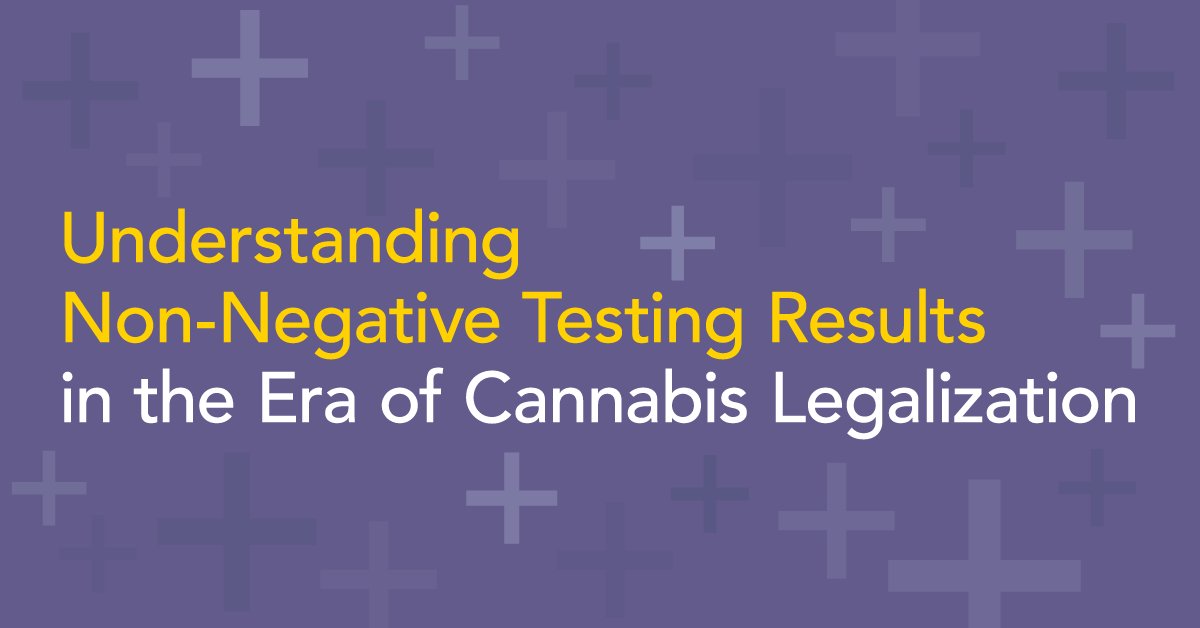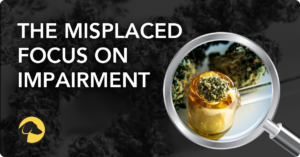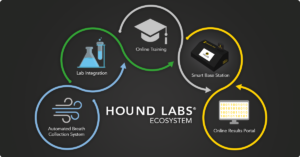
Accentuate the Negative, Deter the Positive
Prior to cannabis legalization, employers could rely on negative and non-negative cannabis test results as confirmation of whether employees were adhering to workplace policy and the law. But the combination of patchwork cannabis laws across the U.S. and traditional testing methods based on zero-tolerance policies, are now making non-negative results a bit harder to understand. And as more states embrace cannabis reform, nothing will go back to the way it was.
In a recent article published in DATIA focus Magazine, Hound Labs’ Nina M. French, current President of the DATIA Headquarters Board of Directors, discusses how employers can fairly address employees’ legal cannabis use and increase their candidate pools by re-evaluating their testing methods and workplace policies.
THE UPSIDE DOWN OF NON-NEGATIVE RESULTS
Nearly 185 million adults in the United States can legally use cannabis. That means, on any given day, gainfully employed people are reporting to work having, at some point, consumed cannabis. The problem is zero-tolerance drug testing policies, and the conventional cannabis tests upon which these policies often rely don’t account for this new legal cannabis landscape. They also don’t distinguish between recent use and long-term use.
The result is valued employees are “failing” cannabis tests, even if they have not recently used cannabis. How is this happening? Because conventional cannabis tests like urine, oral fluid, and hair will provide positive results for days, weeks, and months after use, depending on the type of specimen. So, these positive results may merely reflect employees’ or candidates’ legal choices during their personal time, with no correlation to cannabis use immediately before or during work or correlation with an ensuing workplace incident.
WHAT THE DATA REVEALS
Recent data1 shows post-accident versus pre-employment cannabis positivity increased nearly two times from 2013 to 2021 in the general U.S. workforce and more than five times for the federally mandated safety-sensitive workforce.
Additionally, there was an increase in cannabis positivity across all employee testing categories using oral fluid (over 14% positive) and urine (10% positivity). And post-accident cannabis positives occurred 63.4% more often when compared to pre-employment cannabis positives.
However, interpreting this data is no longer as straightforward as it used to be. This is because employers cannot isolate when employees used THC based on positive test results from conventional cannabis tests of urine, oral fluid, and hair. The inability to identify when an employee used cannabis prevents employers from understanding whether the positive results may have impacted the workday and a potential workplace incident. Positive results reflecting cannabis use that occurred 24 hours to 67 days before the test2 present a challenge to employers now that most employees can legally use cannabis.
WHY RECENT USE MATTERS
Policies based on positive results from conventional tests do not provide employers with a complete, objective story of the result. In the case of a urine test, it is impossible to change a level or further test a positive result to determine if an employee used cannabis within a few hours preceding or during the workday. For example, should an employee be disciplined for using cannabis legally over the weekend or following their shift? Employers wouldn’t act on positive test results for alcohol if an employee consumed two martinis two days prior to testing. Should an employee who legally uses cannabis on a Saturday night be penalized for it on Monday morning? Now that most adults have legal access to cannabis, employers should consider taking a similar position on legal cannabis use – prevention during the workday, not punishment for off-hours use.
In the era of legalization, employers need to re-evaluate methods and policies to ensure they are fair, objective, and support the overall goal of creating a safe workplace and reducing the cost of drug use at work. And, before making any changes to drug testing policies, employers should consult federal regulations and state laws or consult with a qualified employment lawyer.
MODERN POLICIES FOR A MODERN PROBLEM
Prior to legalization, employers could perform pre-employment tests to eliminate candidates who tested positive for THC. This was often a cut-and-dried decision as cannabis use was uniformly illegal. But as the legal landscape continues to evolve and employers continue to grapple with a tight labor market, organizations need and want clear and comprehensive drug testing policies that specifically address legal cannabis use outside of work. Zero-tolerance policies are increasingly impractical.
If an employer fires an employee who legally uses cannabis and follows company policies, this can become a costly action for both employees and employers. The employee is denied a position or loses a job based on legal use outside of the workplace, while the employer incurs recruiting, training, and other employee replacement costs. In addition, the employer loses goodwill with other employees who observe unfair treatment.
So, how can employers create holistic cannabis policies balancing fairness for employee choices outside of the workplace while maintaining a safe workplace in the era of legalization? The answer may lie in a combination of two important steps – first, updating drug testing policies; and second, embracing new technology that can detect and isolate recent use of THC. Only THC breath testing technology is capable of distinguishing between use that has occurred in the past few hours versus the past few days. This allows employers to make an objective decision about whether an employee violated company workday cannabis policies.
A cannabis breathalyzer measures THC in breath and allows for fast, accurate, and on-location results. Automated processing and instrument-read results eliminate the possibility of biased interpretation and reduce human error while administering the test. Instrument-read results are available in minutes at an employer’s workplace, eliminating the burden of supervisors interpreting “the line” on a point-of-care test to determine if it is positive or negative. Some cannabis breathalyzers preserve test results which are automatically and electronically recorded to provide employers with a recoverable log for accurate record-keeping. Finally, the ability to confirm and record the few non-negative tests via LC/MS confirmation and chain of custody protocols mirrors the forensic defensibility workplace testing standards that are universally considered a best practice.
As with any workplace drug testing policies, employers should discuss the incorporation of THC breath testing with legal counsel to review potential options. But the re-evaluation of testing methods to include a cannabis breathalyzer allows employers to continue workplace drug testing (post-hire, random, post-incident, reasonable suspicion, etc.) while attracting highly qualified candidates and retaining valued employees.
Incorporating technology to determine recent cannabis use also allows employers to rethink their return on investment (ROI) model for workplace drug testing. Historically, this model has been driven by the 2-3% of positive test results resulting from the number of drug users – and their associated costs and risks – that a company excludes from the workplace. However, a different ROI model can be used when deploying a breath testing technology. Now that most employees have legal access to cannabis, the model can consider the negative test results as well as the positive ones. It’s no longer just the cost savings of deterrence and risk mitigation; it’s retaining valuable employees and reducing the cost of rehiring employees who were terminated for cannabis use that occurred days, weeks, or months before the test.
Employers should now recognize that legal cannabis is widely available to their candidates and employees. Those who re-evaluate how they test, embrace new technology, and focus policies on isolating recent use of THC will be better able to maintain safe workplaces, fairly address their employees’ legal cannabis use, and increase their candidate pools.
To stay up to date on articles from our subject matter experts be sure to subscribe to our newsletter. For additional insight on how the Hound® solution can improve the effectiveness of your drug testing program, contact us today.
This article originally appeared in the Spring 2022 edition of DATIA focus Magazine.
Footnotes
1 2022 Quest Diagnostics Drug Testing Index™
2 Federal Register

July 28, 2022
By NINA M. FRENCH
Share












